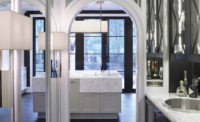Dry-set mortars ANSI A118.4 are commonly called thin-sets and are formulated of Portland cement, sand and water retentive chemicals. This mortar can be limited in that it only forms a mechanical bond to the thin stone and substrate. (Unlike a modified mortar, which forms both a mechanical and adhesive bond.) With the array of thin stone tile types now available — many with dense bodies and low absorption — and regulations limiting and impairing proper preparation of a substrate, it has gotten to a point where mechanical bonding becomes almost non-existent. (To picture a “mechanical bond,” think of Velcro®, with the “barb” side being the mortar. As it hydrates, it grows microscopic arms or “hooks” into the stone and substrate, turning three different layers into one homogenous layer. The adhesive bond is like the adhesive on the back of the Velcro.)
Latex typically refers to a liquid additive (acrylic or SBR) that helps mortars form an adhesive bond to compensate for the lack of mechanical bonding to dense substrates. These mortars exhibit higher bond strengths than ANSI 118.1. Although latex additives are still popular, they have their drawbacks. Some are used only sparingly in the field, offering no advantages at all. Sometimes, they can even generate foam in the mortar if mixed at high speeds. Air entrapment leads to a weak bond as well as low tensile and compressive strengths. Also, latex additives, especially those with high solids, typically take longer to coalesce within the mortar matrix. This extends the mortar’s cure time. If submerged or exposed to rain or wet conditions too quickly, “latex leaching” can occur.
Single-component, polymer-modified mortars serve as an all-purpose adhesive for installing a wide variety of thin stone products over a broad range of substrates. Even though dried polymers have been used in Portland cement-based mortars for more than 30 years, there is still a misunderstanding that they are different from and inferior to the latex additives used with cement mortars. Many times, the dried polymer is the same chemical composition as that found in the latex additive. To get the ultimate performance in today’s demanding environments, it is necessary to use mortars containing dried polymers. There is the misperception that if you add liquid latex to an ANSI 118.1 product, you will get less shrinkage than with the redisperables or premixed 118.4. All liquid latex admixes contain water in varying amounts. Since polymers are dry powders, they can help to reduced shrinkage because less liquid is required to obtain a workable mix.
It is the amount of polymer solids and type of polymers that give mortars the added bond strengths to denser substrates and stones with improved flexibility to more closely match the thermal expansion and contractions of the substrate and stone. By incorporating dry polymers into the mix, it reduces the risk of liquid admixtures being diluted with water prior to mixing with the mortar. Most liquid admixtures are pre-diluted by the manufacturer to the required level for the specific mortar type. Thus, adding additional water would lower the solids content and reduce the effectiveness of the admixture and performance of the mortar.
Lightweight mortars offer the advantages of non-sag for vertical installations, and many of these mortars also perform as non-slump medium-bed mortars, which are perfect for most thin stone and large-format applications to help reduce lippage.
Crack prevention mortars are an economical way to prevent cracks, due to minor substrate movement, from transferring into the stone. These are suitable for when there are minor cracks in the substrate, when the concrete substrate is less than 90 days old, or if there is a large differential between daytime and nighttime temperatures.
Epoxies generate a high degree of adhesion and chemical resistance. Because they contain no water, they are recommended for bonding dimensionally unstable natural stone products (what we typically call moisture-sensitive stone). Moisture-sensitive stones tend to curl or warp when installed with a typical cement mortar. Also, agglomerate marble should be installed with epoxy mortar.
Epoxy ANSI A118.3 should also be the first choice for natural stone products with a fiberglass resin backing. There is no standard for the epoxy or resin used on the back of marble. Each manufacturer or fabricator can use whatever epoxy or resin with a combination of fiberglass mesh or sand cast into the back of a stone.
Summary
Always use a white mortar on light-colored or translucent stone and gray on dark-colored stone. If the stone has a resin backing, use a 100% epoxy mortar (unless you have the stone tested and get the recommendation from the mortar manufacturer for a polymer-modified mortar). To achieve higher bond strength, use an A118.4 polymer-modified thinset. Because some natural stones have lower tensile strengths than tile, a crack prevention mortar should be considered in all applications where there can be movement in the substrate. The addition of a crack isolation membrane meeting ANSI A118.12 would be the best installation, especially for new concrete and essential for Gypsum cement floor underlayments.


